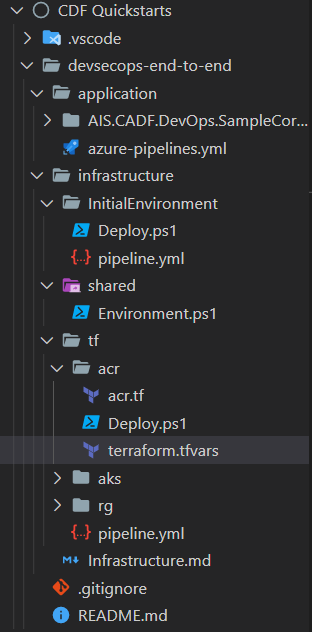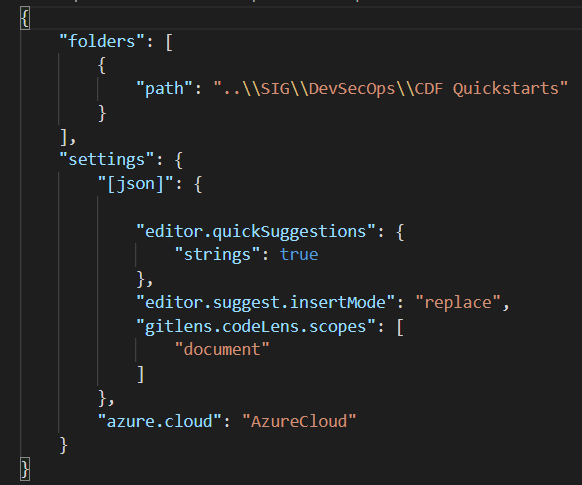From C# Developer to DevOps Engineer
Over the last couple of years, I’ve become a DevOps Engineer after having been primarily a C# developer. Instead of primarily C# and SQL, I was now working almost exclusively with JSON, YAML, and PowerShell. While I was very familiar with Visual Studio 2013/2015/2017 and its excellent support for the .NET work I did over the years, I found the experience for building DevOps solutions to be underwhelming. At the time, the Intellisense for Azure Resource Manager (ARM) or Terraform templates, GitLab or Azure DevOps pipelines, and PowerShell was either non-existent or incomplete. In addition, Visual Studio was quite the resource hog when I wasn’t needing all the extras it provides.
Enter Visual Studio (VS) Code
Now, I had downloaded VS Code soon after it was released with the intent to use it at some point, to say I had. However, after seeing Visual Studio Code used in some ARM template videos where snippets were used, I decided to try it out. Like most Integrated Development Environments (IDE), VS Code isn’t truly ready to go right after installation. It’s taken me some time to build up my configuration to where I am today, and I’m still learning about new features and extensions that can improve my productivity. I want to share some of my preferences.
I want to point out a couple of things. First, I’ve been working primarily with GitLab Enterprise, Azure DevOps Services, and the Azure US Government Cloud. Some of these extensions are purely focused on those platforms. Second, I use the Visual Studio Code – Insiders release rather than the regular Visual Studio Code version. I have both installed, but I like having the newest stuff as soon as I can. For this post, that shouldn’t be an issue.
Theming
As long as there’s a decent dark color theme, I’m content. The bright/light themes give me headaches over time. VS Code’s default dark theme, Dark+, fits the bill for me.
One of the themes I didn’t know I needed before I stumbled across them was icon themes. I used to have the standard, generic folder and file icons, the Minimal theme in VS Code. That made it difficult to differentiate between PowerShell scripts, ARM templates, and other file types at a glance. There are a few included templates, but I’m using the VSCode Icons Theme. It’s one of the better options, but I’m contemplating making a custom one as this one doesn’t have an icon for Terraform variables files (.tfvars), and I’d like a different icon for YAML files. If the included themes aren’t suitable for you, there are several options for both types of themes and Product Icons themes through the marketplace.

Workspaces
Workspaces are a collection of folders that are a “collection of one or more folders are opened in a VS Code window.” A workspace file is created that contains a list of the folders and any settings for VS Code and extensions. I’ve only recently started using workspaces because I wanted to have settings configured for different projects.
Extensions in Visual Studio Code provide enhancements to improve productivity. Extensions include code snippets, new language support, debuggers, formatters, and more. I have nearly 60 installed (this includes several Microsoft pre-installs). We will focus on a handful that I rely on regularly.

Azure Account
The Azure Account extension provides login support for other Azure extensions. By itself, it’s not flashy, but there are a few dozen other Azure extensions that can use the logged-on account from one to reference Azure resources targeted by the others. This extension has a setting, Azure Cloud, that was the main reason I started adopting Workspaces. The default is the commercial version, AzureCloud. I’ve changed it at the user level to AzureUSGoverment, but some of my recent projects use AzureCloud. I’ve set the workspace setting for those.
Azure Resource Manager (ARM) Tools
This extension will make your ARM template tasks much more manageable! It provides an extensive collection of code snippets to scaffolding out many different Azure resources. Schema support provides template autocompletion and linting-like validation. A template navigation pane makes finding resources in a larger template easy. There is also support for parameter files, linked templates, and more.
HashiCorp Terraform
Terraform is an offering of HashiCorp. They’ve provided an extension that supports Terraform files (.tf and .tfvars), including syntax highlighting. While there are only a few snippets included, the autocompletion when defining new blocks (i.e., resources, data) is quite extensive.

GitLens – Git Supercharged
GitLens is full of features that make tracking changes in code easily accessible. I installed this extension for the “Current Line Blame” feature that shows who changed the current line last, when they changed it and more. In addition, there are sidebar views for branches, remotes, commits, and file history that I use regularly. There are several other features that I either don’t use or even wasn’t aware of until writing this post, as well this is an excellent tool for Git repo users.

MSBuild Project Tools
I had a recent project that contained a relatively large MSBuild deployment package that needed to be updated to work with the changes made to migrate the application to Azure. I haven’t worked with MSBuild in several years. When I did, I didn’t have all the syntax and keywords committed to memory. This extension provides some essential support, including element completion and syntax highlighting. It did make the project a little easier to modify.
PowerShell Preview
I’ve become a bit of a PowerShell fan. I had been introduced to it when I was working with SharePoint, but since I’ve been doing DevOps work in conjunction with Azure, I’ve started enjoying writing scripts. The less-than-ideal support for PowerShell (at the time, at least) in Visual Studio 20xx was the main reason I gave VS Code a shot. This extension (or the stable PowerShell extension) provides the excellent IntelliSense, code snippets, and syntax highlighting you’d expect. However, it also has “Go to Definition” and “Find References” features that I relied on when writing C#. In addition, it incorporates linting/code analysis with PowerShell Script Analyzer, which helps you develop clean code that follows best practices.
Wrapping Up
I have far more than these extensions installed, but these are the ones I use the most when doing DevOps work. Some of the others either haven’t been used enough yet, aren’t helpful for a DevOps Engineer, or weren’t interesting enough to list for the sake of brevity.
However, I’ve created a Gist on my GitHub that contains the complete list of extensions I have installed if that’s of interest. Visual Studio Code is an amazing tool that, along with the proper configuration and extensions, has increased my productivity as a DevOps Engineer.






